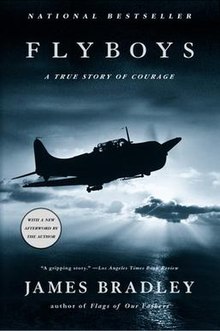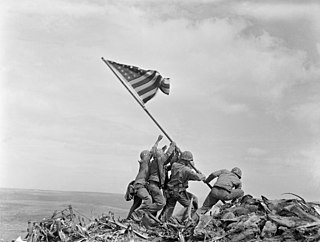
The Battle of Iwo Jima was a major battle in which the United States Marine Corps (USMC) and United States Navy (USN) landed on and eventually captured the island of Iwo Jima from the Imperial Japanese Army (IJA) during World War II. The American invasion, designated Operation Detachment, had the goal of capturing the island with its two airfields: South Field and Central Field.

Iwo Jima, officially romanized and pronounced Iōtō, is one of the Japanese Volcano Islands, which lie south of the Bonin Islands and together with them make up the Ogasawara Archipelago. Together with the Izu Islands, they make up Japan's Nanpō Islands. Although 1,200 km (750 mi) south of Tokyo on Honshu, Iwo Jima is administered as part of the Ogasawara Subprefecture of the Tokyo Metropolitan Government.

The Pacific War of World War II, sometimes called the Asia–Pacific War or the Pacific Theater, was fought in eastern Asia, the Pacific Ocean, the Indian Ocean, and Oceania. It was geographically the largest theater of the war, including the Pacific Ocean theater, the South West Pacific theater, the Second Sino-Japanese War, and the Soviet–Japanese War in the last few months of the war.

The Bonin Islands, also known as the Ogasawara Islands (小笠原諸島), is a Japanese archipelago of over 30 subtropical and tropical islands located around 1,000 kilometers (620 mi) SSE of Tokyo and 1,600 kilometers (1,000 mi) northwest of Guam. The group as a whole has a total area of 84 square kilometers (32 sq mi) but only two of the islands are permanently inhabited, Chichijima and Hahajima. Together, their population was 2,560 as of 2021. Administratively, Tokyo's Ogasawara Subprefecture also includes the settlements on the Volcano Islands and the Self-Defense Force post on Iwo Jima. The seat of government is Chichijima.
The Commando Order was issued by the OKW, the high command of the German Armed Forces, on 18 October 1942. This order stated that all Allied commandos captured in Europe and Africa should be summarily executed without trial, even if in proper uniforms or if they attempted to surrender. Any commando or small group of commandos or a similar unit, agents, and saboteurs not in proper uniforms who fell into the hands of the German forces by some means other than direct combat, were to be handed over immediately to the Sicherheitsdienst for immediate execution.

USS San Jacinto (CVL-30) of the United States Navy was an Independence-class light aircraft carrier that served during World War II. She was named for the Battle of San Jacinto during the Texas Revolution. Future U.S. President George H. W. Bush served aboard the ship during World War II.

Raising the Flag on Iwo Jima is an iconic photograph of six United States Marines raising the U.S. flag atop Mount Suribachi during the Battle of Iwo Jima in the final stages of the Pacific War. Taken by Joe Rosenthal of the Associated Press on February 23, 1945, the photograph was published in Sunday newspapers two days later and reprinted in thousands of publications. It won the 1945 Pulitzer Prize for Photography and has come to be regarded in the United States as one of the most recognizable images of World War II.

Tadamichi Kuribayashi(Japanese: 栗林 忠道, 7 July 1891 – c. 26 March 1945) was a general in the Imperial Japanese Army, diplomat, and commanding officer of the Imperial Japanese Army General Staff. He is best known for having been the commander of the Japanese garrison at the battle of Iwo Jima.

Chichijima (父島) is the largest and most populous island in the Japanese archipelago of Bonin or Ogasawara Islands. Chichijima is about 240 km (150 mi) north of Iwo Jima. 23.5 km2 (9.1 sq mi) in size, the island is home to about 2,120 people (2021). Connected to the mainland only by a day-long ferry that runs a few times a month, the island is nonetheless organized administratively as the seat of Ogasawara Village in the coterminous Ogasawara Subprefecture of the Tokyo Metropolitan Government. Together with the Volcano and Izu Islands, it makes up Japan's Nanpō Islands.
Nobuaki "Warren" Iwatake was an American citizen who was drafted by the Imperial Japanese Army to serve as a radio operator and communications intercepter.

James Bradley is an American author from Antigo, Wisconsin, specializing in historical nonfiction chronicling the Pacific theatre of World War II. His father, John Bradley, was involved in the first raising of the American flag on Mount Suribachi during the Battle of Iwo Jima in 1945.

The Zhejiang-Jiangxi campaign or the Chekiang–Kiangsi campaign, also known as Operation Sei-go, was a campaign by the China Expeditionary Army of the Imperial Japanese Army under Shunroku Hata and Chinese 3rd War Area forces under Gu Zhutong in Chinese provinces of Zhejiang and Jiangxi from mid May to early September 1942.

Beginning in the mid-1930s, Japan conducted numerous attempts to acquire and develop weapons of mass destruction. The 1943 Battle of Changde saw Japanese use of both bioweapons and chemical weapons, and the Japanese conducted a serious, though futile, nuclear weapon program.

The Volcano and Ryūkyū Islands campaign was a series of battles and engagements between Allied forces and Imperial Japanese Forces in the Pacific Ocean campaign of World War II between January and June 1945.
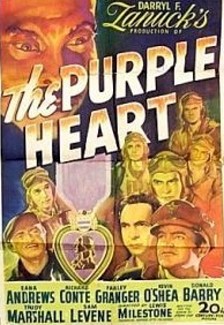
The Purple Heart is a 1944 American war film, produced by Darryl F. Zanuck, directed by Lewis Milestone, and starring Dana Andrews, Richard Conte, Don "Red" Barry, Sam Levene and Trudy Marshall. Eighteen-year-old Farley Granger had a supporting role.
The 109th Division was an infantry division of the Imperial Japanese Army. Its call sign was the Courage Division. It was formed on 24 August 1937 in Kanazawa as a square division, simultaneously with the 108th division. The nucleus for the formation was the 9th division headquarters. It was subordinated from the beginning to the Japanese Northern China Area Army.
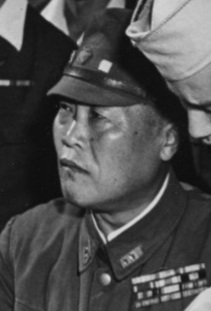
Yoshio Tachibana was a lieutenant general in the Japanese Imperial Army during World War II. He was commander of the Japanese garrison in Chichijima, Ogasawara Islands, and was later tried and executed for the Chichijima incident, a war crime involving torture, extrajudicial execution and cannibalism of American prisoners of war.
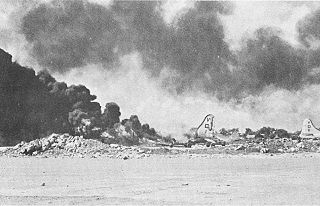
During World War II, a series of Japanese air attacks on the Mariana Islands took place between November 1944 and January 1945. These raids targeted United States Army Air Forces (USAAF) bases and sought to disrupt the bombing of Japan by Boeing B-29 Superfortress heavy bombers operating from the islands. The Japanese lost 37 aircraft during this operation, but destroyed 11 B-29s and damaged a further 43. Preparations were also made for commando raids on the bases in early and mid-1945 but these did not go ahead.
The Enemy Airmen's Act was a law passed by Imperial Japan on 13 August 1942 which stated that Allied airmen participating in bombing raids against Japanese-held territory would be treated as "violators of the law of war" and subject to trial and punishment if captured by Japanese forces. This law contributed to the deaths of hundreds of Allied airmen throughout the Pacific and Asian theaters of World War II. Shortly after World War II, Japanese officers who carried out show trials and illegal executions under the Enemy Airmen's Act were found guilty of war crimes.
The Chichijima incident occurred in late 1944. Japanese soldiers killed eight American airmen on Chichi Jima, in the Bonin Islands, and cannibalized four of them.
